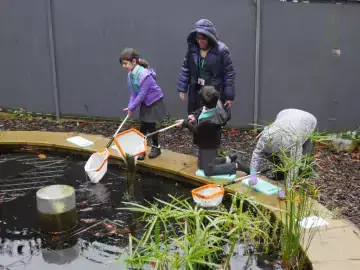
Habitats: Mapping vertical features
Mapping vertical features and the plants they support is part of the Mapping your site activities, enabling you to explore and map the habitats your site currently offers for nature. Understanding your starting point is really important and will allow you to measure any nature gains you achieve when you start making enhancements to your site. Mapping vertical features is one of eight habitat mapping sessions in this unit of learning.
Before mapping any vertical features and the plants they support, the introductory activities have been designed to support learners in understanding or recapping the concepts of horizontal and vertical, exploring how plants can climb up vertical features like walls and fences, and considering how vertical features function as habitats. Completing these activities first will allow them to answer the questions in the Vertical Features Habitat Flowchart accurately.
These can also be used as standalone activities, promoting a positive connection with nature.
You can carry out this activity at any time of year.
Getting to know your space
Preparation
Green skills
- identification and ecology
What you need
- How plants climb cards and vertical features worksheets (Cards, Worksheet, Flowchart and Activity Guide)
- Vertical features habitat flowchart
- a tablet, laptop, or desktop PC to access the online Habitat Mapper tool
- a printed map of your site, if you do not intend to use the Habitat Mapper outdoors
Location
Outdoors
Useful guidance
Resources
Step by step
- Recap younger learners’ knowledge of the concepts of vertical and horizontal. You could do this by playing a movement game where learners move around an indoor or outdoor space and when the teacher signals “vertical” or “horizontal”, the learners make their body into the correct shape. Once learners are confident with the difference – they should run to objects within their environment that are either “vertical” or “horizontal”.
- Discuss with learners: Is there anything living on/in the outdoor vertical features? What do learners already know about plants that might grow in these places?
- How plants climb cards activity. Three suggestions for how to run this activity are given at the top of the cards activity. Select the option you prefer, or run them as a carousel activity.
- Vertical features worksheet. Either add these to the how plants climb cards activity, or use them as a basis for discussion. Which type of plants would grow best on each feature – why? Are some easier for plants to grip on to than others? Students should think carefully about the different strategies the plants use to climb, and whether they are self-supporting or will need to be tied/trained against the vertical feature. Ask how non-climbing plants can also be grown in vertical spaces (hanging baskets, living walls). Considering the things that plants need to survive (light, water, nutrients), what are the pros and cons of a climbing plant rooted in the ground vs a hanging basket or living wall?
- After completing these activities, divide learners into small groups and ask them to find a vertical feature and determine what material it’s made from using the three options on Part One of the Vertical features habitat flowchart.
- On the printed map of your site (or the online Habitat Mapper tool if you have internet connectivity outdoors), educators and learners work together to draw lines to represent these vertical habitats.
- Then ask learners to find a plant living on a vertical feature. Use Part Two of the Vertical features habitat flowchart to identify what type of plants they are. Again, on the printed map of your site or online Habitat Mapper, educators and learners work together to draw lines to represent these vertical habitats.
- Repeat this until you have mapped all the vertical features and plants growing on them, across your site.
- Back in the classroom, if you used a printed map, transfer each line of habitat on to the Habitat Mapper tool, to represent these vertical habitats on the online Nature Park map. This is a really important step to ensure your site and your observations are part of national community science research.
- Return to the Mapping your site page and select the next habitat category you have on site.
Reflection
We usually think of vertical features like fences and walls as boundaries to separate areas from one another. Fences and walls can stop some wildlife moving across a site e.g. hedgehogs that can’t climb over them, but they can also connect distant parts of a site, especially if the fence or wall has plants that create cover for animals while they are moving. Reflect with learners on whether the fences or walls on your site help or block the movement of wildlife.
In small or built-up areas, where there isn’t much space to create new habitats, vertical features provide a potentially untapped resource for wildlife. Ask learners to reflect on how they could think upwards when planning new habitats for nature and create greener natural spaces on human-made vertical features as part of the Education Nature Park.
What to try next
Add other habitats to your Nature Park map

Habitats: Mapping flowers and food
Begin activity
Mapping water habitats
Begin activity